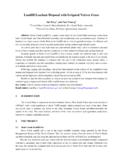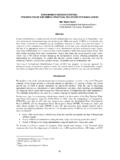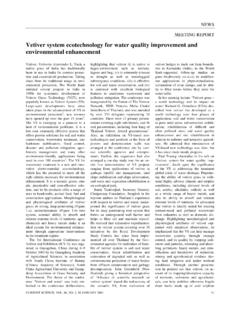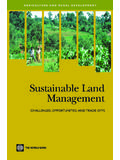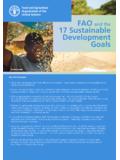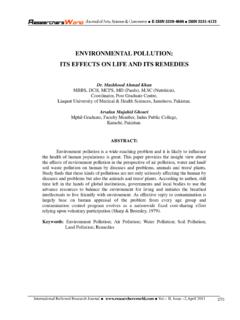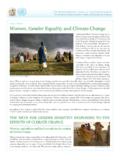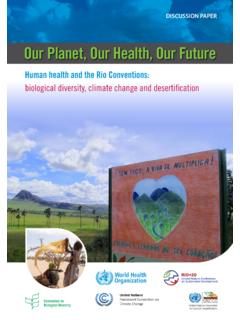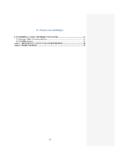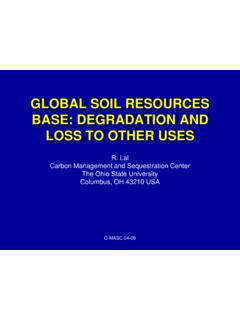Transcription of Vetiver System for Land Reclamation
1 Vetiver System for land ReclamationReviewer Hanping XiaApp lication of the Veti ver System in the Reclamation of Degraded Lan dHanping Xia1, and Wensheng Shu21 South China Institute of Botany, Chinese Academy of Sciences, Guangzhou 510650, China2 School of Life Sciences, Sun Yatsen (Zhongshan) University, Guangzhou 510275, ChinaAbstract: land degradation is becoming one of the severest environmental issues in the world, especiallyin developing nations. land degradation, usually accompanied by soil erosion, always results in adecrease or complete loss of land productivity, and produces on-site and off-site pollution to soil andwater. The methods for land Reclamation are various, including physical, chemical and biological. Thecost for Reclamation of degraded land using old methods is huge, but far cheaper, using new biologicalmethods.
2 Vegetation or revegetation is a chief biological measure, but the key is choosing the rightspecies. Trees, shrubs, creepers, and herbs can be used to reclaim degraded land , but the best species aregrasses due to their strong resistance to adverse conditions, and fast-growing feature. Among them, Vetiver (Vetiveria zizanioides) is the most typical representative. As a species of land Reclamation , vetiverhas various kinds of miraculous characteristics and functions, such as rapid growth, huge biomass,massive and long roots, strong abilities to control erosion and stabilize slopes, and huge capacities ofphytoremediation. Applications around the globe as well as in China indicate that Vetiver is really amiracle species for land Reclamation , including Reclamation to barren mountains or hills, contaminatedwater and soil, mined lands, quarries, etc.
3 It exhibits a very wonderful future in South China for words: Vetiver System , land Reclamation , phytoremediation, erosion control, sustainabledevelopmentEmail contact: Hanping Xia INTRODUCTIONLand degradation is referred to a reduction or loss in the capacity of land to supply benefits tohumanity. It results from an intricate nexus of social, economic, cultural, political, and natural forcesoperating across a broad spectrum of time and spatial scales (Barrow, 1991; Daily, 1995). A great part ofland degradation is derived directly from soil erosion. The two ecological processes, generally concurrent,usually cause a serial of other ecological and social problems. Among them, the most prominent one ison-site and off-site pollution, thus causing a decrease of land productivity or land degradation in the lowerreaches.
4 The main factors evoking land degradation consist of natural or artificial factors, and the artificialfrom industrial or agricultural development, etc. With the development of human society, landdegradation evoked by artificial factors is becoming more and more conspicuous, accounting for a fargreater part of degraded SEVERE SITUATION OF land DEGRADATION AROUND THE GLOBEIt is estimated there has been nearly 2_109 hm2 soil degraded due to excessive artificial activitiessince 1945, accounting for 15% of the total terrestrial areas. Of this, about 750 _106 hm2 (38%) areclassified as lightly degraded (defined as exhibiting a small decline in agricultural productivity andretaining full potential for recovery); about 910_106 hm2 (46%) are moderately degraded (exhibiting agreat reduction in agricultural productivity; amenable to restoration only through considerable financialand technical investment); about 300_106 hm2 (15%) are severely degraded (offering no agriculturalutility under local management systems; reclaimable only with major international assistance); and about9_106 hm2 ( ) are extremely degraded (incapable of supporting agriculture and unreclaimable) (Daily,1995).
5 Up to 2000, 50% of wetlands in the world have been destroyed, and 50% of rivers polluted;desertification has influenced over 100 nations, nearly 1 billion people. At present, the forest resourcevanishes at the speed of 16_106 hm2 annually (Qing et al., 2002). Therefore, it is very urgent to controlland degradation and to reclaim the degraded COMMON METHODS FOR land Reclamation AND THEIR COSTSIn order to rehabilitate or reclaim degraded lands, especially mined lands, various methods havebeen utilized globally. Of them, the physical and chemical methods, such as irrigation, burying, filtration,or removal of pollutants, or similar treatments (Table 1), are extensively used (Bradshaw, 1997; Xia andCai, 2002). However, these methods are generally expensive, and sometimes are impossible to carry out,for the volume of contaminated materials in many cases is very large, especially those produced bymining and industrial far, information on rehabilitation cost is still lack.
6 In general, however, the rehabilitation fordegraded lands by common methods is quite expensive. For example, it is estimated that cleanup ofhazardous wastes by conventional technologies is projected to cost at least $400 billion in the alone;and cleanup of the sites contaminated with heavy metals alone can cost $ billion while mixturesof heavy metals and organics bear an additional $ billion price tag (Salt et al., 1995). UNEP sestimates of the direct annual cost of all preventive and rehabilitative measures range between $ and $ billion, and the direct, on-site cost of failure to prevent desertification during the period1978 1991 at between US $300 billion and $600 VEGETATIVE MEASURES FOR land RECLAMATIONIf wastes cannot be effectively treated or removed, off-site pollution, usually coming from wind orwater erosion or leachate, must be prevented first.
7 An effective approach is the vegetation measure, oneof the most practical and economical methods for pollution control and land Reclamation . Table 1 showsthat the long-term treatment measures for mined land restoration are almost all vegetation or tolerantspecies selection. However, revegetation to polluted sites is often difficult and slow due to the hostilegrowing conditions, which include the toxicity of heavy metals, organic compounds, strong acidity, 1 The major problems of mined land and their Immediate and long-term treatmentmeasures for rehabilitation or Reclamation *Limiting factorProblemImmediate tre atment me thodLong-ter m tre atment methodHea vy me talToo highOrganic matte r or toler antspe ciesTole rant or hyperacc umula torspe ciesAcidityToo lowToo highLimePyr itic waste or organicmatterTole rant species le achingWea thering or tole rant speciesOrganic matte rDef iciencyManure, sludge.
8 Ga rbage Vegetation or toler ant specie sNutr ientN deficiencyDeficiency ofother elementsN f ertilizerAppropriate f ertilize rLegume or other N-fixerMineral weathering or tolerantspe ciesMoisture Too wetToo dryDrainageIrr igation or cove rTole rant speciesTole rant speciesStr uctur eToo compactToo looseRip or scarifyPre ss or cove r with finematerialVegetationVegetation or leac hingOrganic pollutantToo highCovering or irrigationBiodegradationSalinityToo highIrr igationTole rant speciesSta bilityErosionSlippageCoverEngineer ed me asure ( kee ping stone wall)VegetationVegetation or engineere d mea sureTextureToo coar seToo fineOrganic matte r or claye d soilOrga nic matter Natural weatheringVegetation*Cited from Bradshaw (1997), and Xia and Cai (2002); slightly modifiedIn fact, vegetation or revegetation for erosion control, pollution mitigation and land reclamationhas been used since ancient times, usually based on past experience, observation, or empirical example, there was precise recordation in a Chinese ancient agricultural monograph named HuaiNan Zi and finished some 2000 years ago that it should adopt different tillage and culture measures tofertile soil, infertile land , high mountain, and low hill; the places that are not suitable to plant cropsshould be vegetated with trees or resurgence of the practice in a more scientific and methodical manner began in the 1930s inEurope.
9 Over the last two decades, the practice has become more popular due to heightened awareness ofenvironmental issues as well as its availability, persistence, and cheapness (Bradshaw and Chadwick,1980; Peng, 2003). The planting of grasses, legumes, shrubs and trees have been used for quite a fewdecades for land Reclamation with varying degree of results. However, it is very important to selectappropriate plant species according to the different soil and topography situations. Eucalyptus and Acaciaare two types of usually used pioneer trees for land Reclamation in tropical and subtropical regions likeChina, due to their some excellent characteristics, such as rapid growth and relatively strong resistance toharsh environments. But eucalyptus has lots of negative ecological effects. 1) It has a huge waterabsorbing capacity, which makes ground water level decrease distinctly.
10 2) Some kinds of eucalyptus,such as E. exserta and E. urophylla, have strong allelopathic effects, or have significant inhibitions onseedlings growth of many plants, thus making the undergrowth sparse or scarce (Zeng and Li, 1997). 3)Eucalyptus hardens the soil surface (Zhou, 1997a). Acacia like A. mangium or A. aurifuliformis, has alsobeen utilized extensively in the tropics and subtropics for the identical goal. As a pioneer, it takes goodeffect for land Reclamation and ecological restoration in the early stage, but its ecological effects decreasegradually about twelve years later. Another drawback often encountered with A. mangium is that itsbranches are rather brittle and prone to snap in the event of strong winds or typhoons (Hengchaovanich,stem-flow, possibly up to hundreds of litres a day during rain, resulting in local scouring(Hengchaovanich, 1999).



